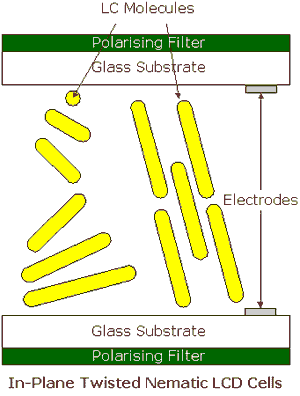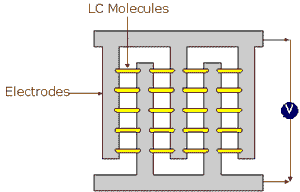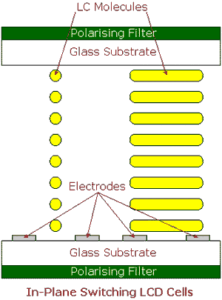If LCDs are ever to replace the CRT-based display, one of the major problems to be overcome is that of narrow viewing angles. Several solutions have been developed but the different approaches have met with varying success when other factors such as contrast, response times and power consumption are taken into account.
In late 1995, Hitachi’s Electron Tube and Devices division showed a prototype of a device first developed in RCA’s labs, the In-Plane Switching (IPS) TFT LCD, which it now calls “Super TFT”. In a conventional TFT LCD, with electrode pairs mounted one above the other on separate substrates, only the lower electrode is switched by a TFT; in the IPS LCD, both electrodes are mounted parallel to each other on the lower substrate, and therefore in the same plane.
In the off position, the molecules of liquid crystal used in Hitachi’s IPS, like those in conventional TFTs, lie parallel to the glass substrates and to each other. They are also aligned to be parallel with the cell’s electrode pair. Unlike the molecules at one end of the chains in the more commonly used STN LCs, however, none of those in an IPS device are anchored to the lower substrate. Consequently, when a voltage is applied across an electrode pair, the LC molecules can all rotate freely through 90° to align themselves with the field, while remaining parallel to the substrates and other molecules above and below them.

The key difference is that all the molecules remain parallel with the substrates, unlike those in a standard TFT where, the further from the anchored end of the chain a molecule is, the more it will attempt to align itself with the field between the two electrodes, at right angles to the substrates. The resulting variation in the angle of the molecules at different cell depths in a conventional TFT causes the angle of the light leaving the cell to be restricted and the optical characteristics of such LCDs to change with increasing viewing angles (i.e. they have anisotropic characteristics). Because this variation in molecule orientation does not exist in an IPS LCD, the display’s viewing angles are greatly increased (to about 140° in all directions) and, though brightness can drop off with an increase in the viewing angle, colour reproduction remains consistent.

Though the contrast ratio of the IPS LCD is good, having two electrodes in each cell cuts the aperture ratio of the cell significantly. The consequent need for a brighter and more power hungry backlight makes it unsuitable for battery-powered applications. The IPS method also results in slower response times, meaning that the LCDs can’t be used to display motion video and are even uncomfortable to use if scrolling around in large areas of data, such as when working on large spreadsheets. These factors have lead some analysts to predict that IPS will be superseded by some other method of increasing viewing angles which does not share the same drawbacks. One contender is a system developed by Fujitsu which can be found in multi-domain vertical alignment. However, the greatly increased viewing angle produced by IPS outweighs power consumption considerations for desktop display usage, and the technology has been adopted, and further developed, by companies such as Compaq, NEC and LG.
Update: IPS has now been developed significantly and has achieved very good viewing angles with consistent colours and acceptable response times. The main commercial supplier of IPS panels is LG.Philips LCD and new in the area is IPS Alpha, a joint venture of Hitachi, Matsushita and Toshiba, which is starting to make TV panels using the technology. NEC and Hitachi also make small volumes of IPS panels. Because of the need for wide viewing angles in mobile TV applications, IPS is moving down even to mobile phone applications.

